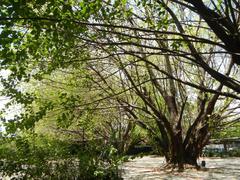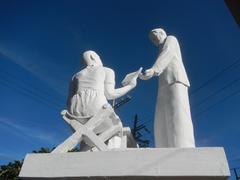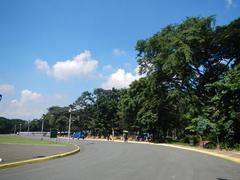National Shrine of the Divine Mercy Marilao: Visiting Hours, Tickets, and Travel Guide
Date: 04/07/2025
Introduction
The National Shrine of the Divine Mercy, nestled in Barangay Sta. Rosa I, Marilao, Bulacan, Philippines, stands as a significant center of Catholic faith and pilgrimage. Since its establishment in the early 1990s and its elevation to national shrine status in 1996, it has welcomed countless pilgrims inspired by the Divine Mercy devotion that originated from Saint Faustina Kowalska’s experiences in Poland during the 1930s. The shrine embodies the Catholic themes of trust, forgiveness, and spiritual healing, resonating deeply with Filipinos and international visitors seeking hope and renewal (wiki2.org, gelouwonders.wordpress.com).
With its harmonious blend of modern architecture and traditional Catholic symbolism, the shrine features a spacious main church, the world’s tallest Divine Mercy statue, and a variety of devotional landmarks like the Guadalupe Chapel, Calvary with life-sized Stations of the Cross, Marian grottos, and the educational Little Poland Museum. These, along with robust community engagement and accessible facilities, make the National Shrine of the Divine Mercy a must-visit spiritual and cultural destination in Bulacan (Philippine Churches, www.shrineofdivinemercy.org).
Table of Contents
- Origins and Foundation
- Elevation to National Shrine Status
- Architectural Highlights
- Devotional Life and Educational Features
- Pilgrimage Culture and Community Impact
- Major Religious Events and Celebrations
- Pilgrimage Programs and Visitor Activities
- Visitor Information
- Travel Tips & Nearby Attractions
- Frequently Asked Questions (FAQs)
- Conclusion & Call to Action
- References
Origins and Foundation
The National Shrine and Parish of the Divine Mercy, or “Pambansang Dambana at Parokya ng Banal na Awa,” was founded to serve the growing devotion to the Divine Mercy, which began through the mystical revelations of Saint Faustina Kowalska in Poland. The first Mass at the site was celebrated on February 2, 1992, marking its role as a center for this global spiritual movement (wiki2.org). The shrine’s architecture reflects both contemporary design and sacred Catholic tradition.
Elevation to National Shrine Status
Due to the rapid influx of devotees and its increasing prominence, the site was declared a National Shrine in 1996 by Archbishop Orlando Quevedo. This designation, overseen by the Diocese of Malolos, solidified its status as an important pilgrimage hub within the Philippine Catholic landscape (gelouwonders.wordpress.com).
Architectural Highlights
Main Church and Design
At the heart of the shrine is the main church—a modern structure designed for both solemn prayer and large gatherings. The spacious nave, adorned with religious icons and stained glass, creates an uplifting and contemplative atmosphere (Philippine Churches).
Divine Mercy Statue
The most striking feature is the towering Divine Mercy statue, standing 45.72 meters (150 feet) tall atop a 15.42-meter (50-foot) podium, making it the tallest Divine Mercy statue in the world and a prominent landmark in Bulacan (Suroy.ph). The statue’s base serves as a multi-purpose hall and dormitory for pilgrims.
Guadalupe Chapel and Healing Water
Beneath the main church is the Guadalupe Chapel, home to a replica of the tilma of Our Lady of Guadalupe. A well within the chapel offers flowing water believed by many to have healing properties (Pinoy Churches).
Calvary and Stations of the Cross
Behind the church, pilgrims can meditate at the life-sized Stations of the Cross and a Calvary scene, particularly popular during Lent (Vigattin Tourism).
Rosary Hill and Marian Grottos
Rosary Hill features markers of the Rosary’s Mysteries, while Marian grottos—including those of Our Lady of Lourdes and the Resurrection—provide tranquil spaces for prayer and healing intentions (HelloTravel).
Little Poland Museum
The Little Poland Museum offers replicas of important Divine Mercy devotion sites, such as the Vilnius convent where Saint Faustina received her visions, Pope John Paul II’s Polish residence, and the Auschwitz cell of St. Maximilian Kolbe (Wikipedia).
Saint Faustina Hall
Saint Faustina Hall accommodates overflow crowds during major feast days and is equipped for catechetical sessions and community events (Wikipedia).
Devotional Life and Educational Features
The shrine supports intense devotional life through daily Masses, confessions, Eucharistic adoration, the 3:00 p.m. Divine Mercy Chaplet, and guided spiritual counseling. Educational exhibits like the Little Poland Museum further deepen understanding of Divine Mercy’s history and message.
Pilgrimage Culture and Community Impact
The National Shrine of the Divine Mercy is among the most visited religious sites in Luzon. Large gatherings on feast days contribute to the local economy, with visitors supporting food stalls, souvenir shops, and local artisans. The peaceful grounds offer sanctuary for prayer, reflection, and spiritual renewal (gelouwonders.wordpress.com).
Major Religious Events and Celebrations
Divine Mercy Sunday
Celebrated on the Sunday after Easter, Divine Mercy Sunday is the shrine’s largest annual event, attracting tens of thousands for Masses, the Chaplet, processions, and healing services (Divine Mercy Sunday 2025).
Jubilee Year of Hope
In 2025, the shrine offers special indulgences for pilgrims as part of the Catholic Church’s Jubilee Year of Hope, with dedicated days for confession, Mass, and the Chaplet (Jubilee Indulgence 2025).
Marian Feasts and Holy Week
The shrine celebrates major Marian feasts, Holy Week liturgies, and regular Healing Masses, fostering vibrant communal worship (Events Calendar).
Pilgrimage Programs and Visitor Activities
- Guided Tours: Available on request, offering insights into the shrine’s history and devotional significance.
- Confession and Spiritual Counseling: Provided daily, with extended hours during major events.
- Outdoor Stations of the Cross: Landscaped route for reflection on Christ’s Passion.
- Special Exhibits and Retreats: Including the Eucharistic Miracles Exhibit and thematic retreats (Eucharistic Miracles Exhibit).
- Volunteer Opportunities: Pilgrims can participate in outreach and community service (Get Involved).
Visitor Information
Visiting Hours & Admission
- Open Daily: 6:00 a.m. – 8:00 p.m.
- Entrance Fee: Free; donations are welcome.
Guided Tours & Accessibility
- Guided Tours: Arrange via the parish office or website (official Shrine website).
- Accessibility: Wheelchair ramps, accessible restrooms, and designated parking are available.
Transportation & Parking
- By Car: Via NLEX, Marilao exit.
- Public Transport: Buses/jeepneys from Manila to Marilao, then tricycles to the shrine.
- Parking: On-site, with overflow lots on feast days.
Dress Code & Conduct
- Attire: Modest dress required; no sleeveless tops or short skirts/shorts.
- Behavior: Reverence and silence in prayer areas; photography allowed outdoors, but not during liturgy.
Safety Protocols
- Security: Personnel on-site during events; medical stations available.
- Health: Hand sanitizers provided; masks optional but recommended on crowded days.
Travel Tips & Nearby Attractions
- Best Time to Visit: Weekdays and early mornings for a quieter experience; Divine Mercy Sunday for festivities.
- Nearby Sites: Barasoain Church, Malolos Cathedral, St. Michael the Archangel Parish, and Bulacan’s heritage museums.
- Local Cuisine: Enjoy Bulacan delicacies from nearby stalls and markets.
Frequently Asked Questions (FAQs)
Q: What are the shrine’s visiting hours?
A: Daily from 6:00 a.m. to 8:00 p.m.
Q: Is there an entrance fee?
A: No; entry is free for all.
Q: Are guided tours available?
A: Yes, coordinate with the shrine office for scheduling.
Q: How do I get to the shrine from Manila?
A: Take NLEX to Marilao exit; public buses and jeepneys also serve the area.
Q: Is the shrine accessible for people with disabilities?
A: Yes, with ramps, accessible restrooms, and parking.
Q: Can I join special events or group pilgrimages?
A: Yes, register groups via the shrine’s contact page in advance.
Conclusion & Call to Action
The National Shrine of the Divine Mercy in Marilao offers a rich spiritual and cultural experience for pilgrims and visitors. With its inspiring architecture, meaningful devotional spaces, and welcoming community, it stands as a beacon of mercy and hope in the Philippines. For updated schedules, events, and guided tour arrangements, visit the official shrine website and follow their social media pages. Download the Audiala app for enhanced pilgrimage information and audio guides. Explore Bulacan’s historical and religious sites on your next spiritual journey.
References and Further Reading
- National Shrine of the Divine Mercy (Philippines), 2025, wiki2.org
- The National Shrine of the Divine Mercy, 2017, gelouwonders.wordpress.com
- National Shrine and Parish of the Divine Mercy, n.d., Philippine Churches
- National Shrine of the Divine Mercy Events and Schedule, 2025, shrineofdivinemercy.org
- National Shrine of the Divine Mercy Visitor Information, 2012, Pinoy Churches
- National Shrine of the Divine Mercy Attractions, 2025, Suroy.ph




